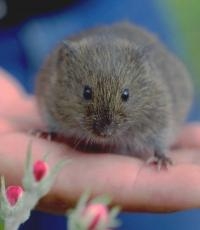The chemistry of love
Submitted on 7 July 2006 - 3:00pm
This article is reproduced by CienciaPR with permission from the original source.
CienciaPR Contribution:
No

By Juan A. Rivero / Special for El Nuevo Día
endi.com
Blame the controversy about love and the belief that it is just a chemical state, on two insignificant mice, known as field voles that respond to the scientific names of Microtus ochrogaster and Microtus montanus.
Voles are similar to common mice but they have a shorter tail, their ears are barely visible, they have underground habits (at least the species that concern us) and only eat vegetal substances. Both M.ochrogaster and M.montanus inhabit dry prairies but M.ochrogaster lives in the low regions and M.montanus lives in mountains and high valleys.
Both species grow fast. The gestation period is of around 24 days, and sexual maturity is reached in 30 days, but there is a fundamental difference between both: M.montanus is totally promiscuous and the male does not show any interest in his pups, whereas M.ochrogaster is monogamous and the male is extremely kind, tender, protective and a supplier for his family. However, genetically, the two species are 99% identical. The level of depredation from vultures, coyotes, vixens and snakes is much more intense in the lower regions and it is assumed that this has induced minimum genetic differences that make both sexes of M.ochrogaster to take part in the protection of their offspring.
When two M.ochrogaster of opposite sex meet randomly, there is an intense licking and sniffing of the female genitals, which causes the liberation of pheromones (volatile chemical substances that affect the other individual) and the beginning of a cascade of hormonal changes which affects mating, the sexual connection, the nesting, the defense of the territory, the childbirth and the parental care.
Predominant in the hormonal cocktail in the beginning of the relation they are the phenylethylamine (abundant in chocolate) and norepinephrine, that accelerates the heart, to keep the pair in alert and create the sensation of pleasing and addiction, causing the pair to feel satisfied and comfortable with each other.
When a female copulates there is a 50% increase in dopamine, that aside from accelerating the heart rate, reinforces the pleasure and the well-being caused by sex. Sex is a pleasant reward, but the lower ground field vole associates it with a particular female whereas the mountain vole associates ti with any female.
In charge of these differences are the hormones oxytocin and vasopresin. If the production of these hormones is blocked, sex becomes a fling, as it happens with the mountain vole, but an injection of these hormones to M.ochrogaster (the lower ground vole) and any type of sexual relation is prevented, the pair continues being monogamous, primping and grooming themselves continuously, as if sex was not necessary to maintain the union.
The reward in this case is a particular female and the relation with her is, really, an addiction. This means that it is possible that a pair of lower ground vole
“fall hopelessly in love” by means of a single injection of appropriate hormones.
When the hormones are injected to the mountain vole nothing happens because although there are hormones, there are no receptors for them in the nucleus accumbens and the ventral pallidium. These are nuclei or groupings of neurons in the base of the brain that are filled with receptors for oxytocin (n. accumbens) and for the vasopresin (ventral pallidus) in the monogamous species, but not in the promiscuous.







